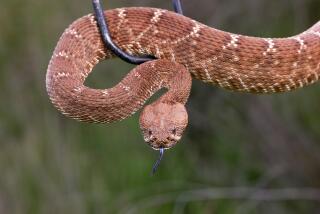Like Any Phobia, Fear of Snakes Puts a Chokehold on the Wandering Spirit
- Share via
I hate snakes. Just looking at pictures of them makes my stomach coil and flesh crawl. When I’m troubled or confused, they slither into my dreams, generally in groups. I never go near the snake house at the zoo and usually scream when I encounter one on a hiking trail or around someone’s neck at Venice Beach.
My phobia has made me nervous about traveling to places where snakes are common and leery about walking in jungles and deserts, and that’s aggravating. When you’re nervous, you can’t fully enjoy seeing and doing new things, and you’re far less likely to take a risk that might result in a wonderful adventure. In this way, my fear of snakes has curtailed my travels.
Snakes figure large in myths all over the world and have long been associated with women. (Think of Eve and of Medusa’s hair.) But when Sigmund Freud suggested that snakes in dreams represent the male reproductive organ, he made my fear of them a hundred times worse because now I wonder whether it means I’m twisted and repressed.
“Sometimes a cigar is just a cigar,” Freud also supposedly said. Surely the urge to light up a stogie is just as natural as the fear of snakes. They look slimy. Their tongues are forked. They don’t have eyelids. And you never know where they’re going to turn up or when they’re going to strike.
I’m fairly sure most men hate them too. But it seems to me that their antipathy usually stems from a reasonable concern about the dangers of snakebite. I’d rather die than get bitten by a snake, and if I did get bitten I know it would be fatal. But that’s not why I hate them. I hate snakes because I’m deeply, irrationally afraid of them, even though I’ve rarely encountered them.
Two months ago, as I was preparing to spend a week with a group studying giant sea turtles on the Pacific Coast of Costa Rica, snakes started to reappear in my dreams. I was excited about the trip, sponsored by the Earthwatch organization, because along with the turtles I hoped to see toucans, tapirs, butterflies, anteaters and howler monkeys. But I did not want to see snakes in the biologically diverse Central American country, which has more than 100 species of the reptile, including bushmasters, coral snakes, boa constrictors, tree vipers and deadly fer-de-lances.
This time, though, I vowed not to let my fear rule me. I did not change my plans even when I learned that Earthwatch advises people who are phobic about snakes or insects not to sign up for the trip. Had any Earthwatchers been bitten? Could snakes get into the condo where volunteers slept? I couldn’t bring myself to ask. Instead, I tried to steel myself, knowing that I was going to a place where serpents are almost as common as house cats.
I made myself look at pictures of snakes and collected stories, like the one my sister-in-law tells about the time she was sitting in her Malibu office and a fat king snake slithered in through the open door. I also decided that immediately after landing in San Jose, the Costa Rican capital, I would visit the Serpentario, a small museum downtown that houses a collection of live reptiles. The purpose of this self-inflicted torture was to face my fear and learn to recognize the kinds of snakes I might meet in Costa Rica, especially the venomous ones.
The Serpentario is on the second floor of a building that looks like a brothel, reached by two dark flights of narrow steps. But once I got inside, it wasn’t bad. The snakes were in glass cases and so still that they looked dead, except for an albino Burmese python (able to consume a man, the label said) that uncoiled itself and stretched toward me, almost bumping its head on the glass. I stood there, horrified and repelled but also a little fascinated. After I left, I felt somewhat fortified against whatever snakes the future held.
Then came more snake stories, some from an American veterinarian participating in the sea turtle project, who said he once wormed a snake. I don’t like worms either, so the idea was doubly disturbing. The tales told by the project manager, a small, delicately made young woman named Susanna who was working on her master’s degree in biology, were remarkable in a different way. Before she began working with turtles, she worked with snakes in Costa Rica and Kentucky, where she used to tramp through swamps, hunting and capturing cottonmouths. The little ones were the hardest to catch, she said. I tend to distrust people who like snakes, but I respected and admired Susanna because her fearlessness meant she could go anywhere and do anything.
I was walking along a dirt road near the beach with two fellow volunteers, both women, when I saw my first snake in the wild in Costa Rica. It had a diamond pattern like a boa constrictor, although I could not be sure that’s what it was. I gasped but did not shriek, then stood still as it retreated quickly and unmaliciously into the vines. My companions seemed unfazed. But I was elated because I’d actually seen a snake not two feet away and hadn’t come undone.
I spent the rest of my time in Costa Rica constantly on guard. One sighting had gone well, but I didn’t want to get tested on a second. And it would be wrong to claim that I have conquered my phobia. I am still afraid of snakes.
I love Ireland and Hawaii, which virtually lack them, for just that reason. And Rudyard Kipling’s cobra-fighting mongoose, Rikki-Tikki-Tavi, still seems to me braver and more lovable than Flicka or Lassie. But I am not going to let snakes keep me from going to South India or the Philippines. That would be unacceptable. Let them do their worst with me in my dreams.
More to Read
Sign up for The Wild
We’ll help you find the best places to hike, bike and run, as well as the perfect silent spots for meditation and yoga.
You may occasionally receive promotional content from the Los Angeles Times.






